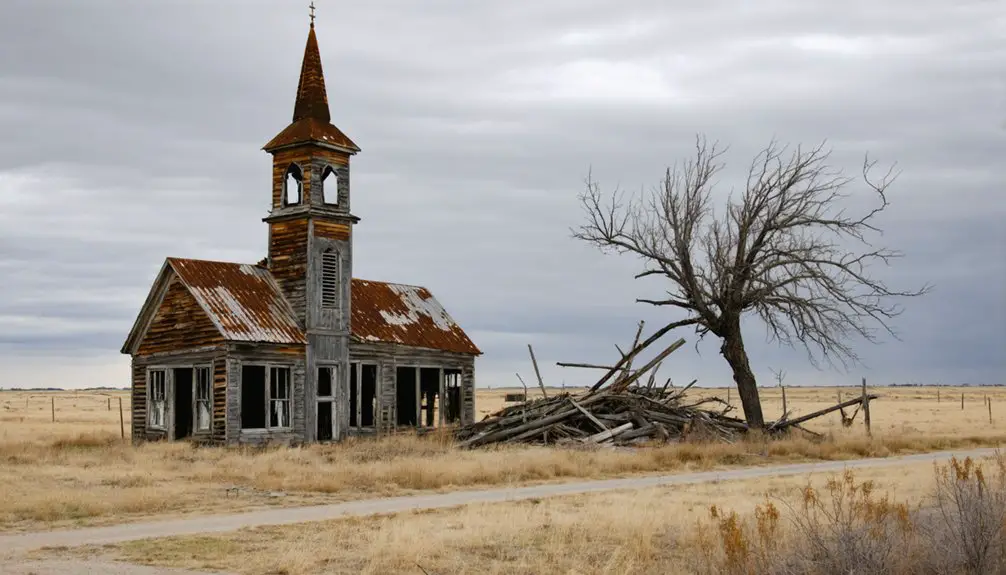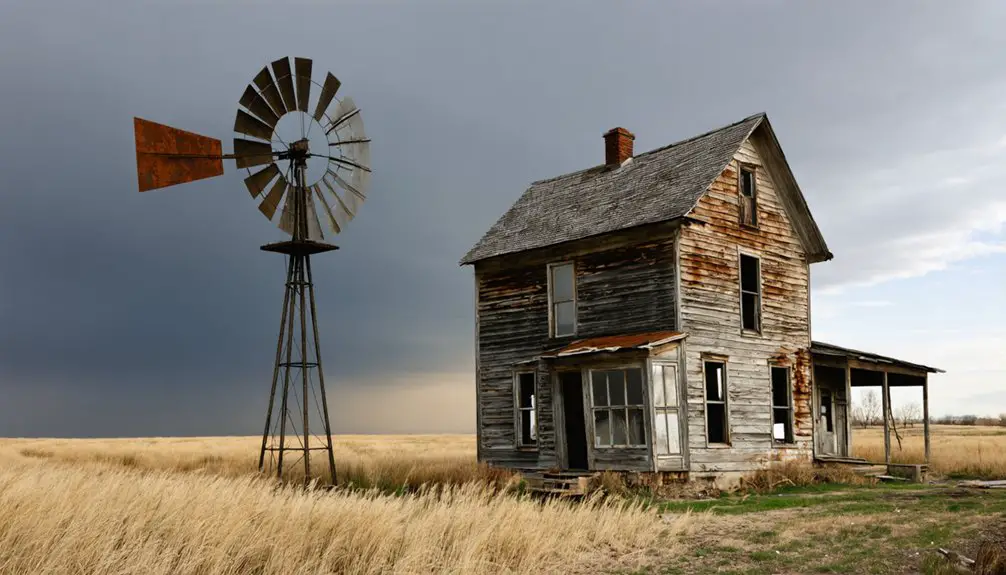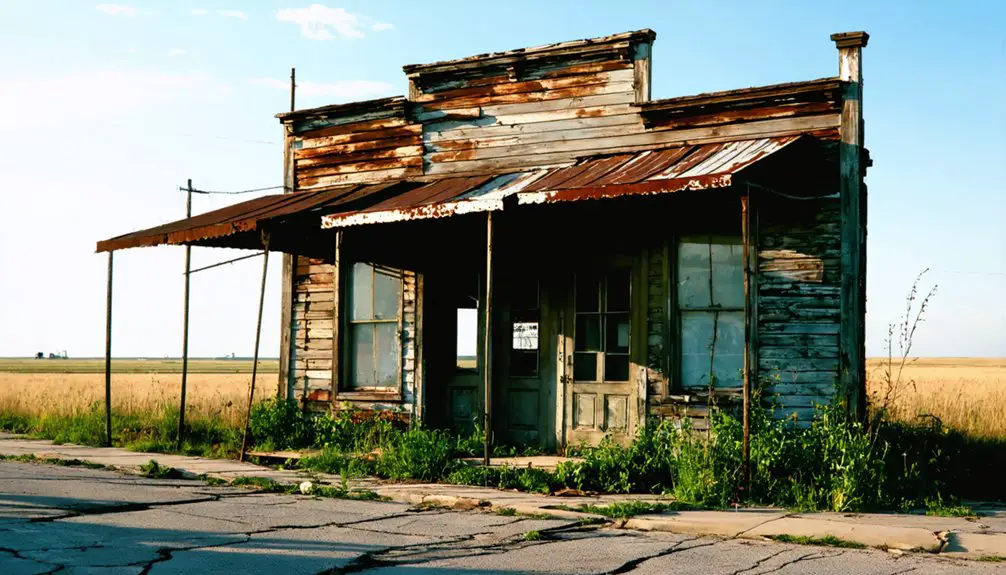You’ll find De Soto’s remains along Nebraska’s Missouri River, where this once-thriving frontier port attracted 700 residents by 1855. Though it flourished as a key commercial gateway with hotels, banks, and trading posts, the town’s fortunes changed dramatically in 1869 when railroad magnate John I. Blair redirected the rail terminus three miles north to Blair, Nebraska. Today, only archaeological evidence tells the story of this forgotten pioneer settlement‘s dramatic rise and fall.
Key Takeaways
- De Soto was founded in 1855 as a thriving Missouri River port town but became abandoned after railroad development shifted commerce elsewhere.
- The town’s decline began in 1869 when railroad magnate John I. Blair established Blair, Nebraska, three miles north.
- Once home to 500-700 residents, De Soto featured hotels, saloons, banks, and stores before its complete abandonment.
- Modern development, including a nuclear power plant, has erased most physical traces of the former pioneer settlement.
- The ghost town’s legacy lives on through archaeological evidence and historical records documenting Nebraska Territory’s early settlement period.
A Frontier Boomtown on the Missouri River
Nestled along the Missouri River’s floodplain in Washington County, Nebraska, De Soto emerged as a promising frontier settlement in 1855. Named after Spanish explorer Hernando De Soto, the town quickly established itself as a significant gateway to the American West, capitalizing on the bustling steamboat traffic along the Missouri River.
You’d have found a thriving hub of frontier life within just three years of its founding, as De Soto’s population swelled to 500-700 residents. The town boasted 30 log buildings, including a hotel, banks, stores, and multiple saloons. At its peak, De Soto had grown so significantly that it actually outpaced Omaha’s size. The area’s significance was documented early on when the Lewis and Clark expedition passed through in 1804.
River trade dominated the local economy, with the town serving as a critical supply point for fur trading posts, frontier settlements, and mining operations. Despite the dangerous river bends that claimed hundreds of steamboats, De Soto’s strategic location made it an indispensable stop for westward expansion.
Economic Growth and Golden Years
During its golden years between 1855 and 1869, De Soto flourished as one of Nebraska Territory’s most promising commercial centers, even surpassing Omaha in size and economic activity at its peak.
Nestled along the Missouri River, De Soto briefly outshone Omaha as Nebraska Territory’s economic powerhouse during its mid-1800s heyday.
You’d have found a bustling town filled with hotels, saloons, banks, and general stores serving both settlers and river travelers. The town’s commercial prosperity attracted substantial workforce migration, with skilled and unskilled laborers flocking to support the rapidly expanding infrastructure. Similar to the Amboy Mill that operated until the 1940s, De Soto’s riverside industries were crucial to the local economy. The Financial Panic of 1857 created economic uncertainty that affected land values and business development throughout the region.
Real estate speculation boomed along the riverfront as investors bet on De Soto’s future dominance. Churches, schools, and newspapers emerged to serve the growing population, while local banks facilitated trade and development.
The town’s strategic location on the Missouri River seemed to guarantee its success until 1869, when the railroad’s decision to bypass De Soto ended its remarkable run.
The Turning Point: Railways and Decline

While De Soto had flourished as a bustling river town through the 1850s and 1860s, its fate changed dramatically in 1869 when railroad magnate John I. Blair chose to redirect the railroad terminus three miles north.
This pivotal decision, influenced by a natural opening through nearby bluffs, led to Blair’s establishment of a new town bearing his name. The railroad decisions triggered rapid population shifts as businesses and settlers abandoned De Soto for the promising rail hub.
The exodus accelerated when news of Colorado gold strikes lured more residents away. Despite initial rail connections and substantial county investments through bonds, De Soto couldn’t compete with Blair’s strategic railway advantage. The Burlington & Missouri River Railroad had invested twenty-six and a half miles of track to reach De Soto by 1870, but this proved insufficient to save the town.
From Bustling Town to Archaeological Site
Today’s archaeological remnants of De Soto tell a stark story of abandonment.
If you’d visited in the mid-1800s, you’d have found a vibrant town with a rich cultural infrastructure of churches, schools, and newspapers. The bustling trading post attracted trappers and merchants, while hotels and saloons served travelers along the Missouri River. Like its namesake Hernando de Soto, who led pioneering explorations across southeastern America, the town embodied a spirit of frontier ambition.
You won’t find much of that now. The town’s physical traces have largely vanished, replaced by modern development including a nuclear plant.
What was once poised to rival Omaha has been reduced to scattered archaeological evidence, preserved mainly through historical records. The transformation from county seat to ghost town happened swiftly after the railroad bypassed De Soto for Blair in 1869, leaving behind only fragments of its frontier legacy.
Legacy of a Lost Pioneer Settlement
Before De Soto became a ghost town, its rich legacy as a pioneer settlement stretched back thousands of years, with prehistoric inhabitants occupying the site as early as 25,000 years ago.
The area flourished as a fur trading post from 1820 to 1854, drawing trappers and merchants from across the region.
You’ll find evidence of pioneer resilience in the stories of settlers like Dr. Simeon Powers and Dr. James Osgood, who helped transform this Mississippi River trading post into a bustling frontier town.
A fascinating cultural fusion emerged as Ho-Chunk traders, European settlers, and missionaries crossed paths at “Winneshiek’s Landing.”
From its peak as the “New Gateway to the West” with 700 residents to its eventual decline, De Soto’s story mirrors America’s westward expansion.
Though the town has vanished, its significance lives on through Fort Atkinson’s military heritage and the agricultural traditions that shaped Nebraska’s early development.
The settlers faced significant challenges breaking the land, with many turning to teams of oxen for the demanding task of plowing the tough prairie sod.
Frequently Asked Questions
What Happened to the Original Residents of De Soto After Abandonment?
You’ll find the relocation impacts split residents between Blair and Fort Calhoun, with many seeking gold in Colorado. Their resident legacies live on through relocated buildings and salvaged materials.
Were There Any Notable Crimes or Lawlessness During De Soto’s Peak Years?
You won’t find documented evidence of major crime incidents during the peak years. While the town had saloons, there’s no record of significant lawlessness or notable law enforcement interventions.
How Did Native American Tribes Interact With De Soto’s Early Settlers?
You’ll find Native Americans initially maintained trade relations and cultural exchange with settlers, though tensions grew as more newcomers arrived, gradually shifting from cooperation to displacement along the Missouri River.
What Was the Average Property Value in De Soto During Its Heyday?
Like a tide rising and falling, you’d find property market values swelling during economic trends of steamboat commerce, but exact figures aren’t recorded. Estimates suggest prime lots commanded premium frontier prices.
Did Any Famous Historical Figures Ever Visit or Stay in De Soto?
While historical visitors passed through via steamboat traffic, you won’t find records of notable guests staying in the town except for Lewis and Clark, who camped nearby in 1804.
References
- https://oppdthewire.com/desoto-history-fort-calhoun-site-2016/
- https://en.wikipedia.org/wiki/Hernando_de_Soto
- https://history.nebraska.gov/wp-content/uploads/2017/04/doc_DeSoto-Washington-County-RG318.pdf
- https://history.nebraska.gov/archeology-of-nebraskas-territorial-period-1854-1867/
- https://omahaexploration.com/2024/06/13/desoto-national-wildlife-refuge-history-wildlife-and-lewis-clark-expedition/
- https://www.fws.gov/refuge/desoto/about-us
- https://www.youtube.com/watch?v=redtU6GT-BY
- https://history.nebraska.gov/wp-content/uploads/2017/11/doc_publications_NH1994Time6_Europeans.pdf
- https://visitnebraska.com/trip-idea/explore-7-authentic-ghost-towns-nebraska
- https://blairhistory.com/archive/early-railroads/



